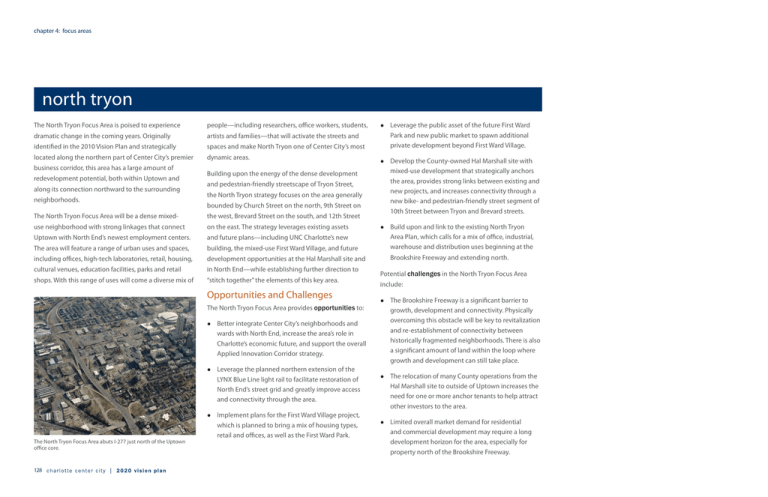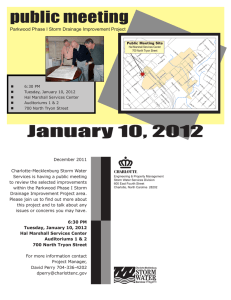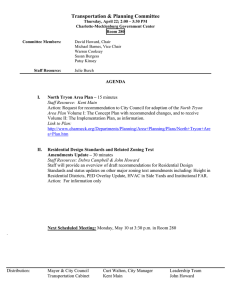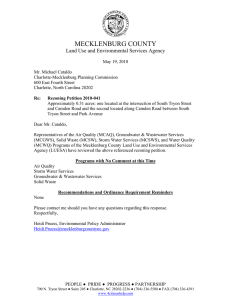North Tryon Vision Plan
advertisement

chapter 4: focus areas north tryon The North Tryon Focus Area is poised to experience people—including researchers, office workers, students, dramatic change in the coming years. Originally artists and families—that will activate the streets and identified in the 2010 Vision Plan and strategically spaces and make North Tryon one of Center City’s most located along the northern part of Center City’s premier dynamic areas. business corridor, this area has a large amount of redevelopment potential, both within Uptown and along its connection northward to the surrounding neighborhoods. Building upon the energy of the dense development and pedestrian-friendly streetscape of Tryon Street, the North Tryon strategy focuses on the area generally bounded by Church Street on the north, 9th Street on ● Leverage the public asset of the future First Ward Park and new public market to spawn additional private development beyond First Ward Village. ● Develop the County-owned Hal Marshall site with mixed-use development that strategically anchors the area, provides strong links between existing and new projects, and increases connectivity through a new bike- and pedestrian-friendly street segment of 10th Street between Tryon and Brevard streets. The North Tryon Focus Area will be a dense mixed- the west, Brevard Street on the south, and 12th Street use neighborhood with strong linkages that connect on the east. The strategy leverages existing assets Uptown with North End’s newest employment centers. and future plans—including UNC Charlotte’s new The area will feature a range of urban uses and spaces, building, the mixed-use First Ward Village, and future Area Plan, which calls for a mix of office, industrial, warehouse and distribution uses beginning at the including offices, high-tech laboratories, retail, housing, development opportunities at the Hal Marshall site and Brookshire Freeway and extending north. cultural venues, education facilities, parks and retail in North End—while establishing further direction to shops. With this range of uses will come a diverse mix of “stitch together” the elements of this key area. Opportunities and Challenges The North Tryon Focus Area provides opportunities to: ● Better integrate Center City’s neighborhoods and wards with North End, increase the area’s role in Charlotte’s economic future, and support the overall Applied Innovation Corridor strategy. ● Leverage the planned northern extension of the LYNX Blue Line light rail to facilitate restoration of North End’s street grid and greatly improve access and connectivity through the area. ● Implement plans for the First Ward Village project, which is planned to bring a mix of housing types, retail and offices, as well as the First Ward Park. The North Tryon Focus Area abuts I-277 just north of the Uptown office core. 128 ● Build upon and link to the existing North Tryon Potential challenges in the North Tryon Focus Area include: ● The Brookshire Freeway is a significant barrier to growth, development and connectivity. Physically overcoming this obstacle will be key to revitalization and re-establishment of connectivity between historically fragmented neighborhoods. There is also a significant amount of land within the loop where growth and development can still take place. ● The relocation of many County operations from the Hal Marshall site to outside of Uptown increases the need for one or more anchor tenants to help attract other investors to the area. ● Limited overall market demand for residential and commercial development may require a long development horizon for the area, especially for property north of the Brookshire Freeway. chapter 4: focus areas north tryon R PA illustrative concept The concept illustrates key recommendations related to connections, development CH UR CH opportunities and catalyst 1 AR PL projects, which are highlighted PO 2 on the following pages. E Edw d dw wi Edwin To T Tow o ow Towers E Development Opportunity b Hal Marshall Site New Development TH e 11 First United Methodist Catalyst Project Alpha Mill TH 1 12 Connection/Linkage E EG LL CO 3 a tR h Lig W LD CA ail a 17 Focus Area Boundary McColl Center 15 T TH KE R AR EV c Go Boulevard Connection D TH ld AR M 10 Local Transit Connection h us BR 5 Ward Loop Connection L EL 9T DW H O LM BE New Street Connection N T L CA Gateway Plaza/Promenade Freeway/Ramp Rail UNC Charlotte UNC Charlotte New Ne N e Public Pu P ubli Market Mar M a arke k First Ward Park First Ward Elementary 4 d IImaginOn Im H 8T 150 300 feet Time Warner Cable Arena H 0 50 N 7T KEY MAP N O DS VI DA R 129 chapter 4: focus areas north tryon recommendations Recommendations CONNECTIONS AND LINKAGES The optimal design and build out of the North Tryon Redevelopment of the North Tryon Focus Area provides Focus Area will evolve over time. There are several an opportunity to restore the street grid and improve key recommendations that, if incorporated as part connections between several areas of Center City. of the final design and implementation, would help Specific recommendations include: ensure North Tryon’s success as a dynamic center of employment, education and Center City living. These include creating strong connections and linkages, capturing key development opportunities, and developing a specific catalyst project. a Reconfigure the Brookshire Freeway. Explore opportunities to reconfigure the Brookshire Freeway between Poplar and Caldwell streets. Ideally, the Brookshire Freeway should be enhanced to improve connectivity and densify land uses. Changes should attempt to eliminate the real and perceived barrier between North End and the northern portion of Uptown. Less-extensive improvements for the shortterm should be identified as part of the I-77/I-277 freeway loop study to insure the complexity and scale of reconfiguring the freeway do not become a roadblock to redevelopment. b Link the Boulevard Loop. As part of the Brookshire Freeway reconfiguration, 11th and 12th streets should be redesigned to become the northern section of the Boulevard Loop in Uptown (see Integrated Transportation Network section in Chapter 3: Transformative Strategies for more detail). c Support the Ward Loop. Unique materials, landscaping and stormwater management should be integrated on 9th Street to link First Ward Park and Fourth Ward Park to adjacent neighborhoods, Tryon Street and other Uptown parks. Reconfiguration of the Brookshire Freeway, 11th and 12th streets, and/or the freeway ramps would open up substantial development opportunities. 130 d Improve Pedestrian and Bicycle Connections. Strong bicycle and pedestrian connections with safe and inviting pedestrian crossings should be provided throughout the North Tryon area, with an emphasis on links to and from public transit. Plans should be implemented to construct 10th Street from Brevard Street to Tryon Street and improve its quality to Caldwell Street. e Enhance Transit Connections. The LYNX Blue Line light rail should be extended north within the existing rail corridor between College and Brevard streets and a new street along the light rail extension should be constructed to help activate the 9th Street station and surrounding area. Attractive shuttle stops should be provided for the Gold Rush trolley. chapter 4: focus areas north tryon recommendations DEVELOPMENT OPPORTUNITIES With much of the North Tryon Focus Area currently characterized by vacant or underutilized land or surface parking lots, development opportunities abound. The blocks along the light rail extension should be home to a mix of educational facilities, housing, retail and smaller office development. Beginning at 9th Street and heading north, North Tryon Street would transition from high-density offices to arts, cultural and educational facilities to light industrial, distribution and offices associated with the Applied Innovation Corridor. Ground floors along Tryon Street should include restaurants and shops to support Center City workers and visitors. First Ward Village should include shops, a new public market, and other services catering to students, residents and workers. Specific recommendations include: 1 Extend the Tryon Streetscape to Brookshire Freeway. The concentration of dense offices and residential towers along Tryon Street should be expanded upon with new high-density employment and/or housing near the intersections of North Tryon Street with 9th and 10th streets. Site-appropriate gateway elements —artwork, signage or other sculptural elements—should be built between the Brookshire Freeway and the Boulevard Loop. 2 Bolster the Applied Innovation Corridor. A strong physical link of development should connect the existing Uptown employment hub concentrated along Tryon Street and support development of the Applied Innovation Corridor. This would entail augmenting the existing light industrial, manufacturing and distribution uses with a mix of new light industrial flex space, research, offices and live-work spaces north of I-277. New buildings should be designed with ornamentation, architectural character and engaging façades fronting the street. 5 Boost Retail and Restaurants. The public market planned for the Seventh Street Station retail space will anchor a new market district. Ground-floor retail and restaurants should be targeted along the new Market Street along the LYNX Blue Line light rail extension. First Ward Park, the new public market and the UNC Charlotte building should attract expanded destination retail, restaurant and entertainment uses over time. A portion of retail should cater to employees, residents and students working, living and studying in the area every day. 3 Establish New Learning Opportunities. Additional educational and lifelong learning uses should be recruited to the North Tryon Focus Area to capitalize on access to the LYNX Blue Line light rail and proximity to UNC Charlotte Uptown, Spirit Square, the Levine Museum of the New South, Discovery Place, ImaginOn and the McColl Center for Visual Art. 4 Create New Residential Opportunities. Mediumto high-density mixed-use housing should be developed east of College Street to serve nearby employees, students, faculty, staff and artists. Higher-density development along Tryon Street should step down when transitioning to existing residential neighborhoods in First and Fourth wards. New development in the North Tryon Focus Area should be medium- to high-density to extend the energy of Tryon Street. 131 chapter 4: focus areas north tryon recommendations CATALYST PROJECT McColl Center While a combination of public improvements and E EG LL CO private investments is required to transform North Tryon, development of the Hal Marshall site would likely have the most significant impact on defining the area’s character and catalyzing development on TH 11 Hal Marshall Site adjacent properties. Site redevelopment should create a distinct identity for the North Tryon area and further T ignite private investment in the district. TH 10 M A E RK The Hal Marshall site is generally bounded by 9th, 11th and North Tryon streets and the planned LYNX Blue Line H 9T light rail extension (see North Tryon Illustrative Concept for more detail). The property is under public ownership and provides a significant amount of land available for redevelopment. The 2020 Vision Plan recommendations for the site build upon the 2010 Vision Plan. Several key elements and design considerations are the ground floors fronting all streets and public rights-of-way. ● High-density office development should be concentrated on the western half of the development to capitalize on the Tryon Street address, extend the Uptown employment hub north toward North End, and provide an anchor for the Applied Innovation Corridor. ● Housing, educational and cultural uses should be concentrated on the eastern portion of the development site with high densities to activate the public realm and support area retail. ● Service functions should not be located along Tryon, 9th and 11th streets or the LYNX Blue Line light rail. The extension of 10th Street from Tryon to Brevard Street provides the opportunity to create a centered street connection that can serve the entire development site. important to ensure the appropriate development of the site: ● Targeted uses should include offices, housing, research and development, and educational and/or cultural uses. ● Development along Tryon Street should attain a high level of design and iconic architecture and should be used to establish a gateway to Uptown and the Applied Innovation Corridor. ● Retail and restaurants should be developed along 132 ● Any necessary access drives should integrate pedestrian pathways, and parking solutions should be shared between buildings. ● Structured parking should serve the site’s development and be integrated below grade or located on upper stories of buildings, with other active uses on the ground floor. Parking structures could also be wrapped with residential, office and institutional buildings. chapter 4: focus areas north tryon recommendations The Hal Marshall site should incorporate nicely-articulated buildings and active ground-floor uses. The Hal Marshall site should include plazas and open spaces similar to those outside the Mint Museum that provide respites from urban activity. Looking south toward the Uptown core, the Hal Marshall site and greater Focus Area should extend the development intensity of Tryon Street; transition in density toward the First and Fourth wards; and capitalize on new development land opened up by future tunneling of the freeway. 133


